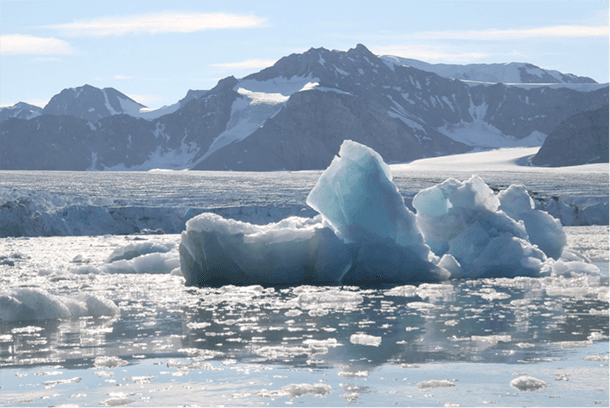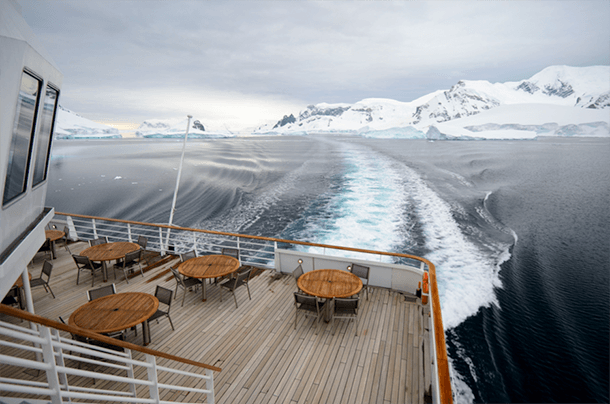The Arctic is opening for business this summer when a cruise ship plies the Northwest Passage
Crystal Cruises’ new luxury vessel will embark on a trip through the Bering Strait and Northwest passage in a trip that begins in Alaska and docks in New York City 32 days later.
As global warming melts more of the sea ice in the Arctic, it’s creating new economic opportunities — from shipping, to oil drilling to tourism. This summer, a 1,000-passenger luxury cruise ship will navigate the receding sea ice through the fabled Northwest Passage.
The Crystal Serenity will travel from Anchorage, Alaska, all the way to the east coast of the United States through the 19,000 islands of northern Canada. The month long voyage will cost passengers between $25,000 and $125,000 depending on whether they choose a penthouse suite or a veranda stateroom. A number of Coast Guard icebreakers, small cruise ships and adventure yachts have made the trip in recent years, but this is the first time a major ocean liner will complete the journey that eluded explorers like James Cook.
When Canadian legal scholar Michael Byers was asked to join the trip as a guest lecturer he had a difficult choice to make. It’s not every day you get paid to cruise the breathtaking high Arctic on one of the most luxurious cruise ships in the world. But Byers turned down the offer because of his concerns about climate change and his unease with what he calls extinction tourism.
“The only reason that the passengers can go to the Arctic is because the Arctic is on the edge of a precipice,” says Byers. “The sea ice is melting and the ecosystem is being overturned. It's a little bit like going to see an endangered species on the savannah of Africa or the Galapagos Islands because you don't think it will be there in five or 10 years. I find that a bit perverse.”
There’s an argument to be made that sending a bunch of rich and powerful people through the Northwest Passage could help fuel momentum for Arctic conservation, but Byers says passengers won’t be able to see the impacts of climate change in a single voyage. And in addition to the trip’s carbon footprint, he worries that cruise ship traffic in the high Arctic will have negative consequences for the species that live there. Whales like the Narwhal, Beluga, and Bowhead are particularly vulnerable.
“These whales are highly sensitive to noise because they communicate using sound,” Byers says, “and if you have large ships passing through this can disrupt the whales while they're mating. That's a concern.”

“A decade ago a small expedition cruise ship sank in Antarctica after striking a growler,” says Byers, “and if the Crystal Serenity were to have that kind of accident happen in the Canadian Arctic, well, quite frankly, I would not want to be on board.”
We reached out to Crystal Cruises for comment and never heard back, but Byers says he isn’t actually that worried about this particular ship. He says Crystal is one the best-run cruise companies in the world, and they’re willing to spend money to ensure safety and minimize the impact on the environment. For instance Crystal chose to voluntarily use expensive low-sulfur fuel because high-sulfur fuel releases particulates that can darken the ice and accelerate melting. And a small icebreaker ship will escort the cruise with a helicopter on deck to assess the ice conditions and assist in the unlikely event that an evacuation is necessary.
Crystal has also been diplomatic in its communication with the small, mostly indigenous communities along the cruise route. Vicki Aitaok runs a tourism company in Cambridge Bay, a 1,500-person town that the Serenity plans to visit. Aitaok is the point of contact between the community and the company, and so far she’s been really impressed with Crystal Cruises.
“They are doing everything right and more,” she says. “They’ve come to the community … they’ve connected with Nunavut regulatory agencies, they’ve connected with government people, the Canadian Coast Guard.” The company also agreed to bring people into Cambridge Bay in 150 person shifts to avoid flooding the town with tourists.
Overall, Aitaok is cautiously optimistic about Crystal Serenity’s visit this summer. “Financially it will definitely have a positive impact,” she says, “and it also provides us with an opportunity to educate people about the Inuit culture.” But she’s not going to make any promises to Crystal or any other cruise company beyond this year.
“We need to see how this year goes, and evaluate it as a community from there as to whether we want to do it again or not. It’s got to be a community decision.”
Even if this summer’s voyage goes well, Byers worries about the precedent it’s setting. “Crystal is going to open the door,” he says, “and Holland America, and Disney and Costa are all going to come in the future because it's a place that people want to visit.” Aitaok recently saw an advertisement from Regency Seven Seas Cruises for a Northwest Passage trip scheduled for the summer of 2017 that would stop in Cambridge Bay. “And they have made no contact with us,” she says. “They can’t just come. It doesn’t work that way.”
Right now, many cruise ships pass along the west coast of Greenland and Alaska, and it’s not hard to imagine those companies extending trips further north. A steady stream of ocean liners could overwhelm the Arctic ecosystem and small communities like Cambridge Bay.
Aitaok’s biggest concern is maintaining the culture of her community. She doesn’t want residents to feel pressure to perform for thousands of tourists. “I don’t want Cambridge Bay people to be like ‘oh a cruise ship is coming let’s put on our uniforms and our outfits and pretend we’re this or that.’ When people come here we show them the real Cambridge Bay … we don’t go build a bunch of igloos. We definitely will recreate traditional lifestyle to show how things have changed over the years, but we’re not going to pretend.”
Regulating cruise ship traffic in the high Arctic could prove difficult because the United States and Canada still disagree on the legal status of the Northwest Passage. Although it’s clearly Canadian, the United States argues that Canada’s domestic laws should not apply, but rather should be treated as an international waterway between the Atlantic and Pacific oceans, open to all.
Byers says if we want to protect the people and wildlife in the high north, the two countries need to sort these questions out. “One of the things that the voyage of the Crystal Serenity should be saying to politicians in Washington and Ottawa is that the Northwest Passage is now opening, we can't afford to have a diplomatic dispute. … Climate change is real. These waters are becoming busy and governments need to get their act together.”
This story first aired as an interview on PRI's Living on Earth.
We want to hear your feedback so we can keep improving our website, theworld.org. Please fill out this quick survey and let us know your thoughts (your answers will be anonymous). Thanks for your time!
